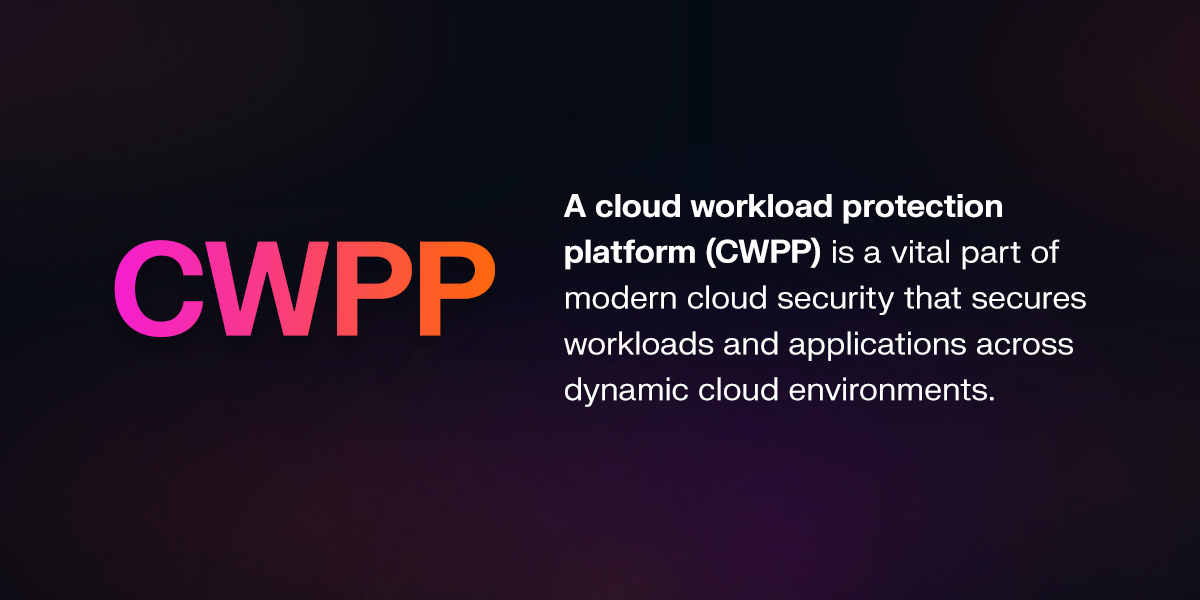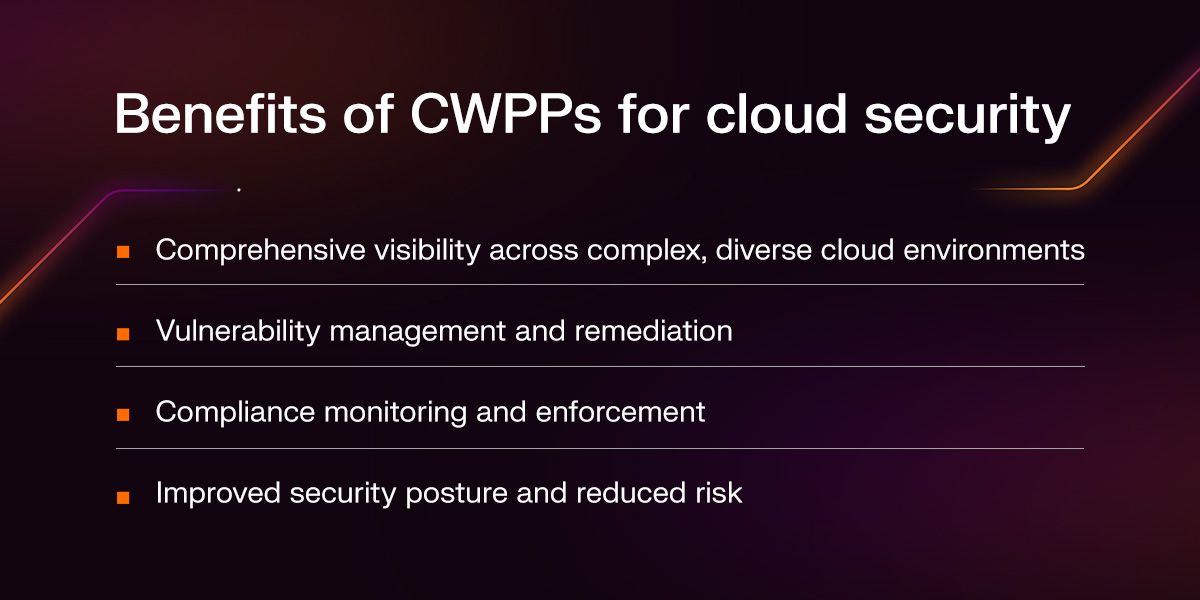What is a Cloud Workload Protection Platform (CWPP)?
What is a cloud workload protection platform?
A cloud workload protection platform (CWPP) is a vital part of modern cloud security that secures workloads and applications across dynamic cloud environments. Its continuous, automated nature enables it to keep pace with the scalable and ephemeral nature of cloud workloads. A CWPP's architecture consists of a data collection and analysis engine, a centralized management console, and a protection mechanism.

What does a CWPP protect?
A CWPP protects the following types of cloud computing workloads from cybersecurity risks:
- Containers: CWPPs protect containerized applications and their supporting infrastructures. They scan dependencies and images, enforce runtime and admission policies, block exploitable network traffic paths, and detect anomalous behavior.
- Virtual machines (VMs): A CWPP enforces least-privilege access and network segmentation, reducing lateral movement across your company's virtualized environments.
- Storage: This tool can detect misconfigurations, enforce access and encryption policies, and scan objects for malware. These capabilities secure data stored in various cloud storage services.
- Databases: CWPPs guard server and container databases that run in cloud environments, preventing data loss and theft.
- Serverless functions: A CWPP secures a serverless application's code and execution. It analyzes code for secrets and vulnerabilities, restricts network or egress paths, and validates identity and access management permissions.
- Physical servers: A CWPP uses host-based agents and applies network controls to help contain risks.
- APIs: CWPPs detect malicious or anomalous API usage to and from workloads, integrating with gateway controls and protecting the application programming interfaces that connect your cloud services. They enforce policies, discover API endpoints that workloads expose, and baseline normal call patterns.
- Service layers: A CWPP uses segmentation, runtime monitoring, and secret hygiene checks to protect interservice communication such as message queues, middleware, and service mesh. This ability safeguards your underlying services and application layers.
Core principles and roles of a CWPP
CWPPs operate on the following principles to protect workloads:
Visibility and control
A CWPP automatically discovers and categorizes your organization's workloads, providing clear visibility across different workload types and cloud environments. This enables centralized management, allowing you to create and enforce more robust security policies from one organized platform.
Threat detection and response
Using a CWPP for threat detection is an effective layer of security to help stop cyber-attacks before they infiltrate your systems. A CWPP uses advanced behavioral analysis to detect suspicious activity and anomalies, employing tools to prevent intrusions. You can also use a CWPP for incident response because it alerts security teams to risks in real time and enables faster intervention.
Vulnerability management
CWPPs can be valuable in vulnerability management since they continuously scan your applications, operating systems, and libraries for vulnerabilities. Risk-based prioritization ranks vulnerabilities based on their potential impact, helping your team focus on the most critical complications. A CWPP also provides actionable recommendations to minimize the attack surface.
Runtime protection
A CWPP monitors workloads at runtime, detecting and preventing malicious activity in real time. It also helps safeguard against in-memory attacks to prevent exploitation.
Compliance and governance
Using a CWPP for compliance and governance can aid you in meeting relevant standards and regulations. These tools automate security policy enforcement across the cloud environment, providing audit trails for accurate forensic analysis and reporting.
What makes CWPPs different from traditional security solutions?
CWPPs are designed specifically for distributed, dynamic cloud environments, offering more comprehensive, continuous protection than traditional security solutions. Traditional security tools such as intrusion detection systems and firewalls are typically perimeter-focused, which can hinder their ability to adapt to the ephemeral nature of cloud resources. Cloud systems lack a fixed network boundary, but a CWPP helps overcome this challenge by focusing on individual workloads within cloud services.
CWPP vs. cloud security posture management
CWPPs and cloud security posture management (CSPM) can work in conjunction to help strengthen cloud security. While a CWPP focuses on protecting the internal workloads and applications within the cloud, a CSPM solution focuses on securing the environments in which those workloads and applications operate. CSPM tools continuously monitor for and remediate misconfigurations and compliance violations.
CWPP vs. endpoint detection and response
A CWPP's protection can also overlap with an endpoint detection and response (EDR) solution. EDR mitigates risks to endpoints such as individual servers, laptops, and mobile devices. While an EDR on its own offers less protection than a CWPP, it can be a crucial component of a multilayered, holistic cybersecurity approach.
Benefits of CWPPs for cloud security

CWPPs offer the following benefits for cloud security:
- Comprehensive visibility across complex, diverse cloud environments: A CWPP mitigates visibility gaps and accelerates incident triage with a single source of truth. This capability reduces manual inventory work, improving capacity planning and accountability across teams.
- Vulnerability management and remediation: CWPPs prioritize what truly matters, shrink backlogs, and reduce emergency downtime. In doing so, they help your organization meet remediation service level agreements (SLAs) and free your teams to focus on high-level priorities rather than low-risk findings.
- Compliance monitoring and enforcement: Implementing a CWPP accelerates your audits and reduces the need to manually gather evidence. A CWPP enforces consistent controls across cloud environments, lowering compliance overhead and the risk of fines.
- Improved security posture and reduced risk: With a CWPP to help protect your cloud systems, you can expect fewer and less severe incidents, a smaller blast radius, and higher availability. Deploying a CWPP can result in measurable posture improvements for increased customer and executive confidence.
Essential features of a CWPP
A CWPP typically offers these features:
- Runtime protection
- Vulnerability scanning and assessment
- Threat detection and intelligence
- Detailed compliance monitoring and reporting
- Workload discovery and inventory
- Microsegmentation
- Network security
- Data loss prevention (DLP)
- Container and Kubernetes security
Real-world examples of CWPP threat protection
Here are some real-world examples of how CWPPs can prevent cloud security incidents:
Preventing data breaches in cloud storage
Imagine an Amazon staging S3 bucket is mistakenly set to public while a compromised Kubernetes pod launches a large volume of malicious "GET" requests. A CWPP's runtime egress controls allow only approved S3 buckets and VPC endpoints, quarantining the pod and blocking transfers in real time.
Detecting and stopping malware infections in VMs
If an internet-exposed Linux VM is hit by an unpatched vulnerability and drops a crypto-miner, a CWPP agent can detect the miner's child-process tree and pool connections, halting the process and isolating the VM from east-west traffic. This triggers a guided patch workflow and contains the incident with minimal downtime.
Ensuring compliance with industry regulations
Imagine a fintech team subject to Payment Card Industry Data Security Standard (PCI DSS) must prove hardening and monitoring of cardholder data workloads across Azure and AWS. A CWPP continuously checks that containers and VMs operate with non-root users. It also ensures encryption is enforced, logs are retained, and auditor-ready evidence is available, which shortens audits and lowers the risk of findings.
Best practices for CWPP implementation
Keep these CWPP security best practices in mind for effective implementation:
- Define clear compliance requirements and security policies
- Automate your organization's CWPP deployment and configuration
- Ensure smooth CWPP integration with existing security workflows
- Continuously monitor and fine-tune your CWPP settings
- Provide ongoing education and training for IT staff
Learn more about cloud protection with Darktrace
Darktrace is a leading cybersecurity partner with advanced, AI-powered solutions built for the dynamic cloud computing environment and evolving adversarial techniques. Our comprehensive technology empowers your team with real-time threat detection capabilities, proactive risk management, and enhanced compliance. Learn more by exploring our blog, reviewing the Darktrace / CLOUD solution brief, or downloading the CISO's Guide to Cloud Security.

























